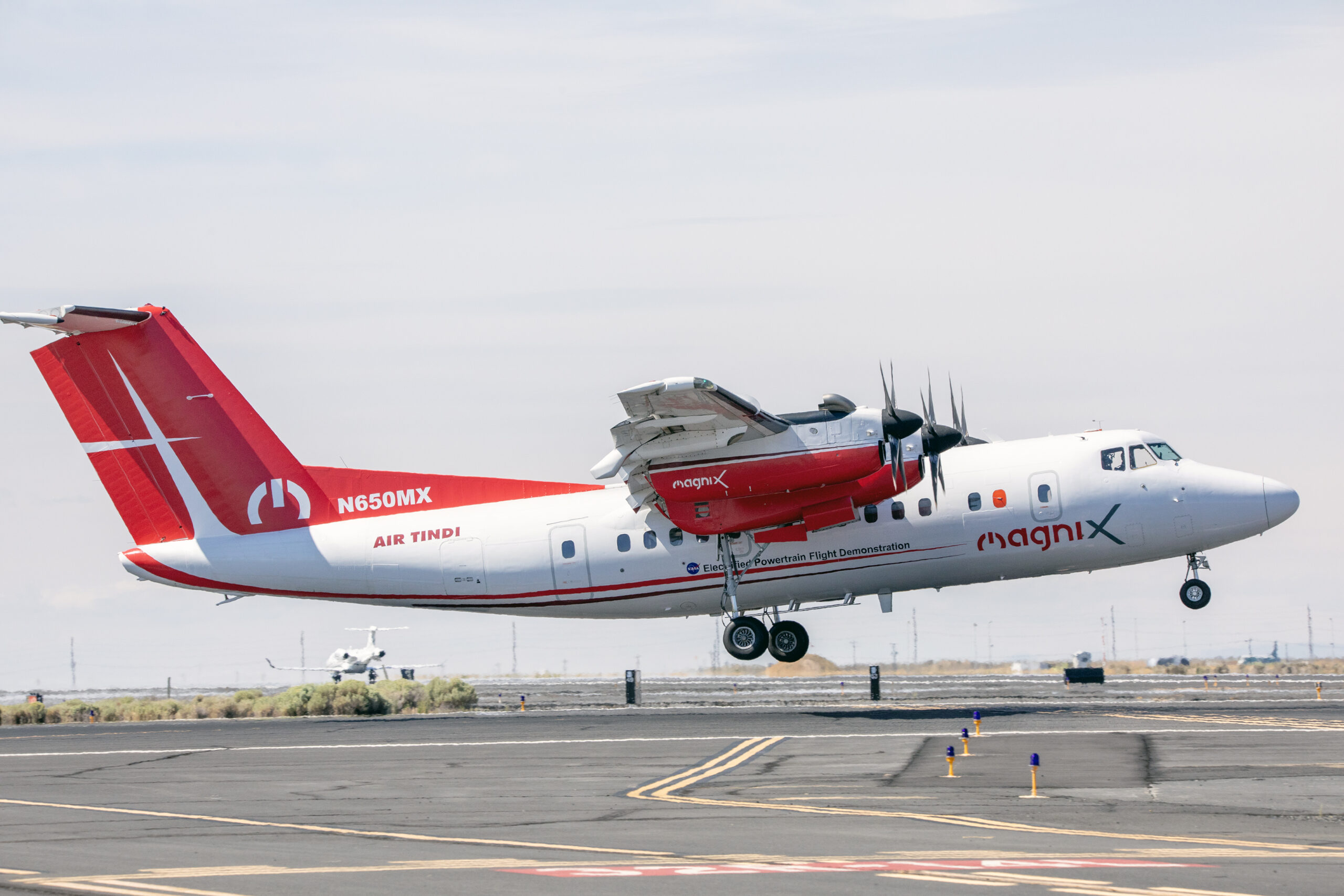Magnifying the Future: The Role of Hybrid Electric Propulsion in Sustainable Aviation
In a significant step towards sustainable aviation, a hybrid electric research aircraft developed by electric motor manufacturer magniX was recently unveiled in Seattle. This aircraft, symbolizing a crucial milestone in the journey towards eco-friendly aviation, was presented during a special ceremony hosted by magniX on August 22. The event took place at King County International Airport, also known as Boeing Field, marking the public debut of the aircraft.
The Aircraft: A De Havilland Dash 7
The aircraft showcased is a De Havilland Dash 7, previously utilized for cargo transportation. Under NASA’s Electrified Powertrain Flight Demonstration (EPFD) project, magniX aims to transform this aircraft into a testbed for hybrid electric propulsion research. The primary objective of this initiative is to demonstrate the potential for fuel savings and enhanced performance in regional aircraft that can accommodate up to 50 passengers. This transformation is a part of broader efforts to minimize the environmental impact of aviation by reducing greenhouse gas emissions.
The Vision: Hybrid Electric Flight Feasibility
The new livery of the Dash 7 highlights the collaborative efforts aimed at demonstrating the feasibility of hybrid electric flight for commercial aircraft. Robert A. Pearce, Associate Administrator for NASA’s Aeronautics Research Mission Directorate, emphasized the significance of this project: “We are a research organization that continues to advance aviation, solve the problems of flight, and lead the community into the future. Through our EPFD project, we’re taking significant steps in partnership to ensure electric aviation is part of the future of commercial flight.”
Collaborative Efforts for Sustainable Aviation
NASA is working with industry partners to retrofit existing aircraft with new electrified propulsion systems. These aircraft testbeds will play a crucial role in showcasing the benefits of hybrid electric systems in reducing fuel consumption and emissions for future commercial airplanes. This initiative is part of NASA’s broader mission to make air travel more sustainable.
Ben Loxton, Vice President for magniX’s EPFD project, mentioned, “EPFD is about showing how regional-scale aircraft, through ground and flight tests, can be made more sustainable using electric technology available right now.” Thus far, magniX has concentrated on developing a battery-powered engine, conducting extensive ground tests to ensure safety and reliability for airborne operations. The project is now transitioning to a new phase, where the Dash 7 will be converted into a hybrid electric research vehicle.
The Transition Phase
“With the recent completion of our preliminary design review and baseline flight tests, this marks the transition to the next and most exciting phase of the project: the modification of this Dash 7 with our magniX electric powertrain,” Loxton said. To achieve this, magniX is collaborating with AeroTEC, an airframe integrator, to modify and prepare the aircraft for upcoming flight tests in Moses Lake, Washington. Additionally, Air Tindi, which provided the aircraft for this project, will assist with maintenance and support during the testing phases.
Understanding Hybrid Electric Propulsion
A hybrid electric propulsion system combines multiple energy sources, such as fuel and electricity, to power an aircraft. For this demonstration, the modified Dash 7 will be equipped with two electric engines powered by battery packs housed in the cabin and two gas-powered turboprops. The initial modification involves replacing one of the outer turboprop engines with a magni650-kilowatt electric engine, the core component of the hybrid electric system. Following successful tests of these modifications, the remaining outer turboprop engine will also be replaced with an electric one.
Ground and Simulated Altitude Testing
Earlier this year, magniX and NASA achieved a milestone by successfully testing the battery-powered engine at simulated altitude conditions. Engineers at magniX are continuing ground tests of the aircraft’s electrified systems and components at NASA’s Electric Aircraft Testbed (NEAT) facility in Sandusky, Ohio. These rigorous tests, simulating various flight conditions such as high altitudes and extreme temperatures, ensure that each component operates safely before actual flight tests.
The Broader Implications
The collaboration between EPFD, NASA, GE Aerospace, and magniX aims to advance hybrid electric aircraft propulsion technologies for next-generation commercial aircraft by the mid-2030s. NASA is partnering with these companies to conduct two flight demonstrations, each showcasing different approaches to hybrid electric system design. Data collected from these ground and flight tests will help identify and address certification gaps, informing the development of new standards and regulations for future electrified aircraft.
Robert A. Pearce expressed his enthusiasm for the potential impact of EPFD: “We at NASA are excited about EPFD’s potential to make aviation more sustainable. Hybrid electric propulsion on a megawatt scale accelerates U.S. progress towards its goal of net-zero greenhouse gas emissions by 2050, benefitting all who rely on air transportation every day.”
Good to Know: The Future of Sustainable Aviation
The development of hybrid electric propulsion systems is a promising step towards reducing the aviation industry’s carbon footprint. By integrating electric engines with traditional fuel engines, hybrid systems can significantly reduce fuel consumption and emissions. This approach not only benefits the environment but also offers potential cost savings for airlines through reduced fuel expenditures.
Industry Reactions and Future Prospects
The aviation industry has shown increasing interest in sustainable technologies, with hybrid electric propulsion being a focal point. Companies like magniX are at the forefront of this movement, pushing the boundaries of what is possible with current technology. The successful implementation and testing of hybrid electric systems could pave the way for widespread adoption in commercial aviation, leading to quieter, more efficient, and environmentally friendly air travel.
Conclusion
The unveiling of the hybrid electric research aircraft by magniX marks a significant milestone in the journey towards sustainable aviation. Through collaborative efforts with NASA and other industry partners, the EPFD project aims to demonstrate the feasibility and benefits of hybrid electric propulsion systems. As this project progresses, it holds the promise of transforming the aviation industry, making air travel more sustainable and environmentally friendly for future generations.
By staying informed about these advancements, we can better appreciate the ongoing efforts to create a greener and more sustainable future for aviation. Keep following our blog for the latest updates and insights into the world of technology and sustainable innovations.
For more Information, Refer to this article.



































